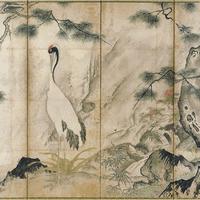雪舟
せっしゅう
Sesshū
Sesshū
Sesshu
großes Boot mit einem Dach, das zum Bootfahren auf einem See oder Fluss verwendet wird
skipper of a snow boat
grand bateau avec un toit utilisé pour naviguer sur un lac ou une rivière
grande imbarcazione con tetto, utilizzata per la navigazione su un lago o un fiume
grote boot met een dak die wordt gebruikt om op een meer of rivier te varen
duża łódź z dachem używana do pływania łódką po jeziorze lub rzece
barco de grandes dimensões com um teto utilizado para navegar num lago ou num rio
большая лодка с крышей, используемая для катания на озере или реке
великий човен з дахом, що використовується для катання на озері або річці
舫
雪州
こんにちは 。人 から 分かる 3分 美術 史 。今日 は 雪 舟 に ついて 勉強 して いきましょう。
|じん||わかる|ぶん|びじゅつ|し|きょう||ゆき|ふね|||べんきょう||いき ましょう
|||||||||snow||||||
|||||arte||||||||||
مرحبًا . 3 دقائق من تاريخ الفن يمكن للناس فهمها. دعونا ندرس عن Sesshu اليوم.
Hello . 3 minutes of art history from a human being. Today we will learn about Sesshō.
雪 舟 。1420年 生まれ 。室町 時代 の 禅僧 であり 、日本 独自 の 水墨 画 の 礎 を 築いた 画家 と して 知ら れます。
ゆき|しゅう|とし|うまれ|むろまち|じだい||ぜん そう||にっぽん|どくじ||すいぼく|が||いしずえ||きずいた|がか|||しら|れ ます
|||||||||||||||foundation|||||||
||||Muromachi|||monge zen|||única||pintura a tinta da água|pintura||fundamento||construiu|pintor||||é conhecido
Sesshû, born in 1420, was a Zen monk of the Muromachi period (1336-1573). A Zen monk of the Muromachi period (1336-1573), Sesshō is known as the painter who laid the foundation for Japan's unique ink painting style.
雪舟 は 、足利 4代 将軍 ・義 持 の 時代 に 、現在 の 岡山 県 に あたる 備中 国 に 生まれました。
ゆき ふね||あしかが|だい|しょうぐん|ただし|よし|もち|じだい||げんざい||おかやま|けん|||びっちゅう|くに||うまれ ました
||Ashikaga||||||||||||||Bitchū|||
Sesshū||Ashikaga||shogun|Yoshi|possessed||||present||Okayama|prefecture||corresponding to|Bichu|||was born
||Ashikaga|da|general|Yoshi|||||||Okayama|prefeitura|||Bitchū|||
Sesshu was born in Bitchu Province, which is now Okayama Prefecture, during the reign of Yoshimochi, the fourth shogun of Ashikaga.
武家 の 生まれ でした が 、幼い 頃 より 出家 。10歳 頃 から 京都 の 臨済宗 相 国 寺 に 入ります。
ぶけ||うまれ|||おさない|ころ||しゅっけ|さい|ころ||みやこ||りんざいしゅう|しょう|こく|じ||はいり ます
Samurai||||||||||||||Rinzai-Schule|||||
warrior family|||||young|||became a monk||||Kyoto||Rinzai sect|Sō||||
samurai|||||infantil|||monasticismo||||||Zen Budismo Rinzai|||||
He was born into a samurai family but became a monk from a young age. He entered the Rinzai sect at Shōkoku-ji Temple in Kyoto around the age of 10.
そこ で 雪 舟 は 、禅 を 当代 有数 の 禅僧 であった 周 藤 、絵 を 足利 家 の 御用 絵師 を 務めた 画 僧 ・周文 に 学びました。
||ゆき|しゅう||ぜん||とうだい|ゆうすう||ぜん そう||しゅう|ふじ|え||あしきき|いえ||ごよう|えし||つとめた|が|そう|あまね ぶん||まなび ました
|||||||der Gegenwart|||Zenmönch|||||||||||||||Shūbun||
||||||||one of the best|||||||||||official|painter||served|||Shūbun||
|||||Zen||da atualidade|de renome||monge zen|||藤|pintura||Ashikaga|||oficial|pintor||serviu|||Shūbun||aprendeu
There, Yuk舟 studied Zen under the prominent Zen monk Shū Tō, and the painter Shū Bun, who served as the official painter for the Ashikaga family.
1454年 、35歳 の 雪 舟 は 、現在 の 山口 県 に あたる 周防 国 に 移住 。守護 大名 である 大内 氏 の 庇護 の もと 画僧 と して 地位 を 築き 始めます。
とし|さい||ゆき|ふね||げんざい||やまぐち|けん|||すおう|くに||いじゅう|しゅご|だいみょう||おおうち|うじ||ひご|||が そう|||ちい||きずき|はじめ ます
||||||||||||Suō|||||||Ōuchi||||||Maler-Mönch||||||
||||||||Yamaguchi|||corresponds to|Suō|||migration|shugo|feudal lord||Ouchi|||protection||under|painter|||position||established|
|||||||||||||||mudança|protetor|||Ōuchi|||proteção||sob a proteção|pintor de quadros|||posição||construiu|
In 1454, at the age of 35, Yuk舟 moved to Suō Province, which is present-day Yamaguchi Prefecture. Under the protection of the prominent daimyō Ōuchi clan, he began to establish his position as a painting monk.
この頃 の 雪 舟 の 作品 は 、荒々しい 画風 で 知ら れる 中国 の 浙派 に 倣った もの で 、当時 の 主流 であった 繊細な 南宋 画 に 対して ユニークな もの と なって います。
このごろ||ゆき|ふね||さくひん||あらあらしい|がふう||しら||ちゅうごく||せつは||ならった|||とうじ||しゅりゅう||せんさいな|みなみ そう|が||たいして|ゆにーくな||||い ます
||||||||||||||||||||||||Südliche Song-Dynastie||||||||
|||||||||||||||||||||mainstream||delicate|Southern Song||||||||
|||||obra||áspero|estilo de pintura||||||Escola de Zhejiang||inspirado|||naquela época||corrente||delicada|Dinastia Song do Sul||||única||||
At this time, Yuk舟's works were influenced by the rough painting style of the Chinese Zhe school, making them unique compared to the delicate Southern Song paintings that were mainstream at the time.
1467年 、48歳 の 雪 舟 は 大内 氏 の 命 で 、当時 の 中国 の 王朝 であった 明 へ の 使節 に 同行。
とし|さい||ゆき|ふね||おおうち|うじ||いのち||とうじ||ちゅうごく||おうちょう||あき|みん||しせつ||どうこう
||||||Ouchi||possessive particle|order||at that time||||dynasty||Ming|||envoy||accompanied
|||||||senhor||ordem||||||dinastia|era|Ming|||embaixada||acompanhou
In 1467, at the age of 48, Fubun accompanied a delegation to the Ming dynasty, which was the ruling dynasty of China at that time, on the orders of the Ōuchi clan.
師 の 周文 、弟子 の 秋月 ら と ともに 中国 へ 渡ります。
し||あまね ぶん|でし||あきつき||||ちゅうごく||わたり ます
|||||Akiyuki||||||geht über
teacher||Zhou Wen|disciple||Akizuki||||||
mestre||Zhou Wen|discípulo||Akiyuki|||junto|||vai atravessar
Together with his master Shuibun and his disciple Akizuki, he crosses over to China.
そこ で 雪 舟 は 、大内 氏 の 使節 と して の 仕事 を し ながら 、中国 で の 近年 の 絵画 潮流 を 学び 、また 多く の 名所 を 訪れました。
||ゆき|ふね||おおうち|うじ||しせつ||||しごと||||ちゅうごく|||きんねん||かいが|ちょうりゅう||まなび||おおく||めいしょ||おとずれ ました
||snow|||Ouchi|||envoy|||||||||||recent years||painting|painting trend||||||famous places||visited
||||||||emissário|||||||||||nos últimos anos||pintura|corrente||||||pontos turísticos||visitou
There, Sekifū fulfilled his duties as an envoy of the Ōuchi clan while studying recent trends in painting in China, and he also visited many famous sites.
2年 の 滞在 を 経て 帰国 。その後 雪 舟 は 、中国 の 風景 を 実際 に 見て きた 画家 と して 人気 を 博します。
とし||たいざい||へて|きこく|そのご|ゆき|ふね||ちゅうごく||ふうけい||じっさい||みて||がか|||にんき||はくし ます
|||||||||||||||||||||||erhält
||stay||after|return to Japan|||||||scenery||actually||||painter|||popularity||gains popularity
||estadia||após|retorno ao país|||||||paisagem||realmente||||pintor|||||terá sucesso
After a two-year stay, he returned to his country. Following that, Sekifū gained popularity as a painter who had actually seen the landscapes of China.
また 、中国 渡航 で 得た 友人 たち の 力 を 借り ながら 、画僧 と して 確固たる 地位 を 築いて いきます。
|ちゅうごく|とこう||えた|ゆうじん|||ちから||かり||が そう|||かっこたる|ちい||きずいて|いき ます
|China|travel||obtained||||||||painter||as|firm|position||establish|
||viagem||||||||emprestado||pintor de quadros|||sólida||||
Furthermore, while borrowing the strength of friends gained during his travels to China, he built a solid position as a monk painter.
この頃 の 雪 舟 の 山水 図 を 見て いきましょう。
このごろ||ゆき|ふね||さんすい|ず||みて|いき ましょう
|||||Landschaftsmalerei||||
|||||landscape painting|picture||look at|let's go
|||||paisagem de montanha e água|imagem|||
Let's take a look at the landscape paintings of Yukibune from this period.
荒々しい 筆 致 と 、大岩 の 隙間 から 城郭 を 覗いた 大胆な 構図 が 特徴 です。
あらあらしい|ふで|いた||おおいわ||すきま||じょうかく||のぞいた|だいたんな|こうず||とくちょう|
rough|brush|with||big rock||gap||castle||peeked at|bold|composition||feature|
|pincel|||grande rocha||fenda||castelo||olhou|audacosa|composição||característica|
It is characterized by a rough brushwork and a bold composition that peeks at the castle through the gap between large rocks.
極端な まで に 抽象 化 さ れた 岩 や 、地面 に 唐突に 置か れた 墨 など が リズミカル であり 、雪 舟 の 代表 作 の 一 つ と して 知ら れます。
きょくたんな|||ちゅうしょう|か|||いわ||じめん||とうとつに|おか||すみ|||||ゆき|ふね||だいひょう|さく||ひと||||しら|れ ます
|||||||||||||||||rhythmisch|||||||||||||
extreme|||abstraction|abstraction|||||ground||suddenly|placed||ink|||rhythmic|||||||||||||
extremo|||abstração||||||solo||de repente|colocado||tinta|||rítmico|||||representante|obra|||||||
The extremely abstracted rocks and the ink suddenly placed on the ground are rhythmic and known as one of the representative works of Sesshū.
続いて 「慧 可 断 臂 図 」。達磨 大師 の 故事 を 描いて います 。写実 的な 人物 の 顔 と 、達磨 が 着た 衣 の 抽象 的な 描写 が 対照 的 と なって います。
つづいて|さとし|か|だん|ひじ|ず|だるま|だいし||こじ||えがいて|い ます|しゃじつ|てきな|じんぶつ||かお||だるま||きた|ころも||ちゅうしょう|てきな|びょうしゃ||たいしょう|てき|||い ます
||||Arm||Daruma|Meister||||||realistische|realistische||||||||||||||||||
next|wisdom|can|to cut|arm|diagram|Daruma|master|possessive particle|story||drawing||realistic||person||||Daruma||wore|clothes||abstract||depiction||contrast|contrasting|||
|Hui|pode||||Daruma|Mestre||história||||realista||pessoa||||||usou|roupa||abstrata||descrição||contraste||||
Next is 'The Diagram of Huike Cutting off His Arm.' It depicts the story of Bodhidharma. The realistic faces of the characters contrast with the abstract depiction of the robes worn by Bodhidharma.
雪 舟 は 1508年 に 87歳 で 亡くなった と いわれて います 。その 生涯 で は 、中国 の 模倣 で は ない 日本 の 水墨画 を 確立 しました。
ゆき|ふね||とし||さい||なくなった||いわ れて|い ます||しょうがい|||ちゅうごく||もほう||||にっぽん||すいぼく が||かくりつ|し ました
|||||||||||||||||||||||Tuschmalerei|||
||||||||||||lifetime|||||imitation||||||ink wash painting|||established
||||||||||||vida|||||imitação||||||pintura a tinta da água||estabeleceu|
It is said that Sesshū passed away at the age of 87 in 1508. Throughout his life, he established a style of Japanese ink painting that was not an imitation of Chinese art.
その後 、江戸 時代 を 迎える と 、狩野 派 が 雪 舟 を 師 と 仰いだ こと で 神格化 さ れ、
そのご|えど|じだい||むかえる||かの|は||ゆき|ふね||し||あおいだ|||しんかく か||
|||||||||||||||||Vergöttlichung||
||||welcoming||||||||||regarded|||deification||
depois disso|Tóquio|||||Kano|Escola|||||mestre||olharam para cima|||deificação||
Later, as the Edo period approached, the Kano school revered Sekisyu as a master, elevating him to a divine status.
現代 に おいて も 日本 の 美術 史上 を 代表 する 画家 の 一 人 と して 知られて います。
げんだい||||にっぽん||びじゅつ|しじょう||だいひょう||がか||ひと|じん|||しら れて|い ます
modern||||||art|history||represent||painter|||||||
moderno|||||||história||representar||pintor|||||||
Even in modern times, he is known as one of the representative painters in the history of Japanese art.
以上
いじょう
acima
The end.

